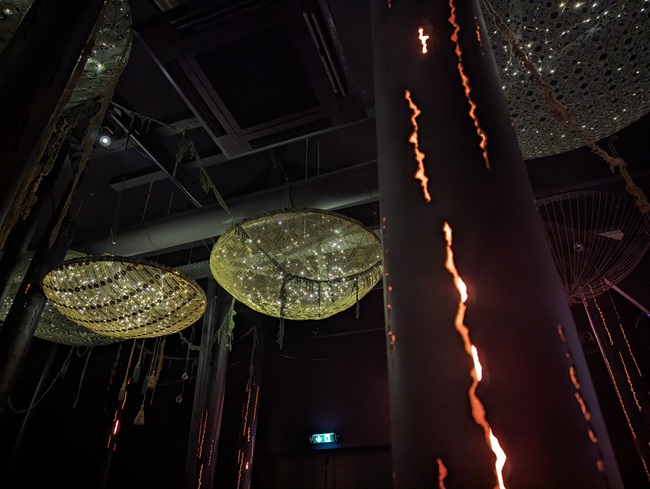Rebuilding William the Conqueror’s Ship in Honfleur
Opening later this month, La Mora’s construction-show is the larger-than-life project to resurrect the flagship that bore William the Conqueror from Normandy to the shores of England in 1066. France Today enjoyed an exclusive preview of the site in Honfleur before its inauguration.
It’s a light-grey early afternoon in the picture-perfect town of Honfleur. The last of this morning’s market stallholders are packing up their wares. Only the squawking of the seagulls can be heard and it’s a very pleasant – and unusual – view over the fishing port and the Lieutenance from where I stand. I’m at the edge of a formerly abandoned port site where sparkling new buildings have risen and old ones beautifully restored, their red and beige bricks shining against the milky white sky. The most impressive one is a huge, wooden, cathedral-like hangar which stands to the side of the site and has no walls, only thick wood pillars holding up a light-wood roof.
I’m here to have a privileged sneak peek of the La Mora project, a somewhat mad idea that celebrates 1,000 years of maritime history in Normandy. Blending exhibition, performance and boatbuilding in real time, the aim of the project is to reconstruct La Mora, the flagship of the Duke of Normandy, also known as William the Conqueror, that led a huge fleet of Normans to England.

The future café and boutique © Sophie Gardner-Roberts
An immersive step in time
The site is divided into two sections. First, an immersive, staged, walk-through exhibition that makes use of cutting-edge technology like mapping, projection and stunning hand-built decors. Visitors step through different rooms, led by a voiceover telling the epic of William’s accomplishment – how he set sail to conquer England, raising an army and boarding thousands of men, horses and goods onto 1000 ships. The sets are beautifully decorated, plunging visitors into medieval Normandy, culminating into an impressive 360° display, giving you the sense you are travelling aboard La Mora with William.
But the star of the show is this large hangar in which the building of the ship will take place. Still in construction when I visited late February, the sheer size of it is testament to the scale of the 34m-long ship that will be hand-built here. My guides tell me that four carpenters, specialised in Danish boat architecture, will be working six days a week on the boat and available to answer questions from the public who will be able to walk around the building site.
Most astonishing of all, they will be working without official documentation but basing their work on the iconography of the Bayeux tapestry and research done by the eminent Roskilde Museum in Danemark. The project is, in other words, based on “experimental architecture”. Period tools from the 11th century will be forged on site but some modern tools will also be used.
By 2027, they hope to have a floating hull and aim to set it in the water, in time for the 1000th anniversary of William the Conqueror’s birth. The entire ship should be finished in five years. Plenty of time then to visit, not once but several times, to appreciate the evolution of the project.

Hand-carved decors and cutting-edge projection in the walk-through exhibition-show © Sophie Gardner-Roberts
A living exhibition
And that is indeed the idea behind the project. Tickets are two-fold: the walk-through exhibition experience and access to the building site. For a first visit, a dual ticket is highly recommended but for subsequent visits, you can purchase only the ticket to access the hangar.
Visits to the exhibition space are done in groups and spaced out every 10 minutes. Several languages are available, so it is recommended you check ahead when an English showing is available to time your arrival correctly. I visited with family, including one family member in wheelchair and the whole experience is well thought-through for people with reduced mobility. The performance is enthralling for old and young visitors alike so children are more than welcome, and they will love to watch all the details of each room.

Screens are built into the decor, the better to understand the history of William the Conqueror’s endeavour © Sophie Gardner-Roberts
A positive, local impact
The project is the brainchild of the brilliant Alain Bourdeaux who is also behind the rebuilding of the Hermione tall ship. Normandy held a special place in his heart and, in Honfleur, he saw the perfect place to honour William the Conqueror’s heritage. He founded a non-profit in 2018 and created this wonderfully hybrid, five-fold project: historical restoration, medieval shipyard, experimental architecture, educational performance and, above all, social dimension. Indeed, he insisted that the project have a positive social impact on the local community.
While Alain has now passed away, a brilliant and passionate team have taken up the torch and the mammoth task of bringing his ideas to life.
Young apprentices – from les Apprentis d’Auteuil, an organisation that accompanies boys and girls from underprivileged backgrounds or difficult family situations to learn skills and find a trade – built the forge which will be used on site. They were thus able to not only learn the different trades involved in building such a site but also took part in a cultural project that is unique in the world.
The aim of the La Mora non-profit is to enable the training and employment of young people, offering a wide range of internships on site but also real support in the pursuit of a career for young adults.
By resurrecting this abandoned location, part of Rouen’s old maritime port, local Honfleurois will be able to explore a part of their home and enjoy a never-before-seen view of their town, which I was gazing at at the beginning of my visit. A boutique and café have also been built on site and boast two large terraces that overlook the courtyard and the town across the water.
I look forward to returning, to witness the carpenters working their magic on the huge treet trunks that have to be brought in from local forests. In the meantime, Honfleur has just added yet another draw to the destination, one that celebrates a shared history between France and England.
2 quai de la Jetée de l’Est, Honfleur
Opening March 23-24 2024 – for the inauguration of the site, a whole host of activities will take place on site, including a medieval camp, children’s workshops, a musical parade from Sainte-Catherine church to the site, an historical conference and visits from the SNSM sea rescuers.

Earth lights and nature-inspired decor in the Yggdrasil room © Sophie Gardner-Roberts
Lead photo credit : The cathedral-hangar where the ship will be built © Sophie Gardner-Roberts
Share to: Facebook Twitter LinkedIn Email
More in coastal towns in France, French history, Honfleur, Normandy, port
Leave a reply
Your email address will not be published. Required fields are marked *






REPLY